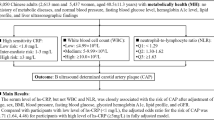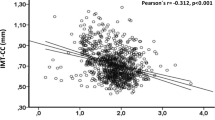Abstract
Background/Objectives:
A cluster of metabolic abnormalities termed metabolic syndrome (MetS) is associated with vascular endothelial dysfunction and oxidative internal milieu. We examined whether the association of MetS with subclinical atherosclerosis is explained by biomarkers of endothelial damage and oxidative stress.
Subjects/Methods:
Multi-Ethnic Study of Atherosclerosis (MESA) is a population-based study of 45- to 84-year-old individuals of four US ethnicities without clinical cardiovascular disease. A random sample of 997 MESA participants had data on the following biomarkers: von Willebrand factor, soluble intercellular adhesion molecule-1 (sICAM-1), CD40 ligand (CD40L), soluble thrombomodulin, E-selectin and oxidized LDL (oxLDL). We examined whether the associations of MetS with B-mode ultrasound-defined common and internal carotid intimal–medial thickness (IMT) and coronary artery calcium (CAC) measured using computerized tomography were explained by the biomarkers using multiple regression methods.
Results:
MetS was associated with higher levels of each of the biomarkers (P<0.001, CD40L-suggestive association P=0.004), with greater IMT (P<0.001), and with greater extent of CAC in those in whom CAC was detectable (P=0.01). The association of MetS with measures of subclinical atherosclerosis remained unchanged after adjustment for the biomarkers. After adjusting for MetS, oxLDL was suggestively associated with greater prevalence of detectable CAC (P=0.005) and thicker internal carotid IMT (P=0.002), whereas sICAM-1was significantly associated with greater prevalence of detectable CAC (P=0.001).
Conclusions:
The association of MetS with subclinical atherosclerosis was independent of its association with biomarkers of endothelial damage and oxidative stress, suggesting that metabolic abnormalities and oxidative endothelial damage may lead to atherosclerotic disease through distinct mechanisms.
This is a preview of subscription content, access via your institution
Access options
Subscribe to this journal
Receive 12 print issues and online access
$259.00 per year
only $21.58 per issue
Buy this article
- Purchase on Springer Link
- Instant access to full article PDF
Prices may be subject to local taxes which are calculated during checkout
Similar content being viewed by others
References
Agatston AS, Janowitz WR, Hildner FJ, Zusmer NR, Viamonte Jr M, Detrano R (1990). Quantification of coronary artery calcium using ultrafast computed tomography. J Am Coll Cardiol 15, 827–832.
Aukrust P, Muller F, Ueland T, Berget T, Aaser E, Brunsvig A et al. (1999). Enhanced levels of soluble and membrane-bound CD40 ligand in patients with unstable angina. Possible reflection of T lymphocyte and platelet involvement in the pathogenesis of acute coronary syndromes. Circulation 100, 614–620.
Bertoni AG, Wong ND, Shea S, Ma S, Liu K, Preethi S et al. (2007). Insulin resistance, metabolic syndrome, and subclinical atherosclerosis: the Multi-Ethnic Study of Atherosclerosis (MESA). Diabetes Care 30, 2951–2956.
Blann AD, Lip GY, McCollum CN (2002). Changes in von Willebrand factor and soluble ICAM, but not soluble VCAM, soluble E selectin or soluble thrombomodulin, reflect the natural history of the progression of atherosclerosis. Atherosclerosis 165, 389–391.
Carr JJ, Nelson JC, Wong ND, McNitt-Gray M, Arad Y, Jacobs Jr DR et al. (2005). Calcified coronary artery plaque measurement with cardiac CT in population-based studies: standardized protocol of Multi-Ethnic Study of Atherosclerosis (MESA) and Coronary Artery Risk Development in Young Adults (CARDIA) study. Radiology 234, 35–43.
Constans J, Conri C (2006). Circulating markers of endothelial function in cardiovascular disease. Clin Chim Acta 368, 33–47.
Grundy SM, Cleeman JI, Daniels SR, Donato KA, Eckel RH, Franklin BA et al. (2005). Diagnosis and management of the metabolic syndrome: an American Heart Association/National Heart, Lung, and Blood Institute Scientific Statement. Circulation 112, 2735–2752.
Halcox JP, Donald AE, Ellins E, Witte DR, Shipley MJ, Brunner EJ et al. (2009). Endothelial function predicts progression of carotid intima-media thickness. Circulation 119, 1005–1012.
Hamburg NM, Larson MG, Vita JA, Vasan RS, Keyes MJ, Widlansky ME et al. (2008). Metabolic syndrome, insulin resistance, and brachial artery vasodilator function in Framingham Offspring participants without clinical evidence of cardiovascular disease. Am J Cardiol 101, 82–88.
Holvoet P (2008). Relations between metabolic syndrome, oxidative stress and inflammation and cardiovascular disease. Verh K Acad Geneeskd Belg 70, 193–219.
Holvoet P, Collen D (1994). Oxidized lipoproteins in atherosclerosis and thrombosis. FASEB J 8, 1279–1284.
Holvoet P, Harris TB, Tracy RP, Verhamme P, Newman AB, Rubin SM et al. (2003). Association of high coronary heart disease risk status with circulating oxidized LDL in the well-functioning elderly: findings from the Health, Aging, and Body Composition study. Arterioscler Thromb Vasc Biol 23, 1444–1448.
Holvoet P, Jenny NS, Schreiner PJ, Tracy RP, Jacobs DR (2007). The relationship between oxidized LDL and other cardiovascular risk factors and subclinical CVD in different ethnic groups: the Multi-Ethnic Study of Atherosclerosis (MESA). Atherosclerosis 194, 245–252.
Holvoet P, Kritchevsky SB, Tracy RP, Mertens A, Rubin SM, Butler J et al. (2004). The metabolic syndrome, circulating oxidized LDL, and risk of myocardial infarction in well-functioning elderly people in the health, aging, and body composition cohort. Diabetes 53, 1068–1073.
Holvoet P, Lee DH, Steffes M, Gross M, Jacobs Jr DR (2008). Association between circulating oxidized low-density lipoprotein and incidence of the metabolic syndrome. JAMA 299, 2287–2293.
Holvoet P, Vanhaecke J, Janssens S, Van de Werf F, Collen D (1998). Oxidized LDL and malondialdehyde-modified LDL in patients with acute coronary syndromes and stable coronary artery disease. Circulation 98, 1487–1494.
Jacobs M, van Greevenbroek MM, van der Kallen CJ, Ferreira I, Blaak EE, Feskens EJ et al. (2009). Low-grade inflammation can partly explain the association between the metabolic syndrome and either coronary artery disease or severity of peripheral arterial disease: the CODAM study. Eur J Clin Invest 39, 437–444.
Katz A, Nambi SS, Mather K, Baron AD, Follmann DA, Sullivan G et al. (2000). (2000) Quantitative insulin sensitivity check index: a simple, accurate method for assessing insulin sensitivity in humans. J Clin Endocrinol Metab 85, 2402–2410.
Lawson C, Wolf S (2009). ICAM-1 signaling in endothelial cells. Pharmacol Rep 61, 22–32.
Matthews DR, Hosker JP, Rudenski AS, Naylor BA, Treacher DF, Turner RC (1985). Homeostasis model assessment: insulin resistance and beta-cell function from fasting plasma glucose and insulin concentrations in man. Diabetologia. 28, 412–419.
NCBI (2011) SNP Database. Vol. 2009. http://www.ncbi.nlm.nih.gov/projects/SNP/snp_ref.cgi?rs=5491 (Accessed 4 April 2011).
O’Leary DH, Polak JF, Wolfson Jr SK, Bond MG, Bommer W, Sheth S et al. (1991). Use of sonography to evaluate carotid atherosclerosis in the elderly. The Cardiovascular Health Study. Stroke 22, 1155–1163.
Register TC, Burdon KP, Lenchik L, Bowden DW, Hawkins GA, Nicklas BJ et al. (2004). Variability of serum soluble intercellular adhesion molecule-1 measurements attributable to a common polymorphism. Clin Chem 50, 2185–2187.
Sakkinen PA, Wahl P, Cushman M, Lewis MR, Tracy RP (2000). Clustering of procoagulation, inflammation, and fibrinolysis variables with metabolic factors in insulin resistance syndrome. Am J Epidemiol 152, 897–907.
Schonbeck U, Libby P (2001). CD40 signaling and plaque instability. Circ Res 89, 1092–1103.
Spiel AO, Gilbert JC, Jilma B (2008). von Willebrand factor in cardiovascular disease: focus on acute coronary syndromes. Circulation 117, 1449–1459.
Tang W, Pankow JS, Carr JJ, Tracy RP, Bielinski SJ, North KE et al. (2007). Association of sICAM-1 and MCP-1 with coronary artery calcification in families enriched for coronary heart disease or hypertension: the NHLBI Family Heart Study. BMC Cardiovasc Disord 7, 30.
Vaidya D, Szklo M, Ding J, Tracy R, Liu K, Saad M et al. (2007). Agreement of two metabolic syndrome definitions and their association with subclinical atherosclerosis: multi-ethnic study of atherosclerosis cross sectional study. Metab Syndr Relat Disord 5, 343–352.
Wu KK (2003). Soluble thrombomodulin and coronary heart disease. Curr Opin Lipidol 14, 373–375.
Wu KK, Aleksic N, Ballantyne CM, Ahn C, Juneja H, Boerwinkle E (2003). Interaction between soluble thrombomodulin and intercellular adhesion molecule-1 in predicting risk of coronary heart disease. Circulation 107, 1729–1732.
Acknowledgements
This research was supported by contracts N01-HC-95159 through N01-HC-95169 from the National Heart, Lung and Blood Institute. We thank the other investigators, the staff and the participants of the MESA study for their valuable contributions. A full list of participating MESA investigators and institutions can be found at http://www.mesa-nhlbi.org. In addition, DV was supported by UL1 RR 025005 from the National Center for Research Resources, and funding for PH was provided by the Interuniversitaire Attractiepolen Programma of the Belgian Federal Government (P06/30) and the Bijzonder Onderzoeksfonds of the Katholieke Universiteit Leuven (OT/06/56).
Author information
Authors and Affiliations
Corresponding author
Ethics declarations
Competing interests
The authors declare no conflict of interest.
Additional information
Supplementary Information accompanies the paper on European Journal of Clinical Nutrition website
Supplementary information
Rights and permissions
About this article
Cite this article
Vaidya, D., Szklo, M., Cushman, M. et al. Association of endothelial and oxidative stress with metabolic syndrome and subclinical atherosclerosis: multi-ethnic study of atherosclerosis. Eur J Clin Nutr 65, 818–825 (2011). https://doi.org/10.1038/ejcn.2011.47
Received:
Revised:
Accepted:
Published:
Issue Date:
DOI: https://doi.org/10.1038/ejcn.2011.47
Keywords
This article is cited by
-
Gene polymorphisms associated with non-alcoholic fatty liver disease and coronary artery disease: a concise review
Lipids in Health and Disease (2016)
-
Butyrylcholinesterase and γ-Glutamyltransferase Activities and Oxidative Stress Markers Are Altered in Metabolic Syndrome, But Are Not Affected by Body Mass Index
Inflammation (2013)



